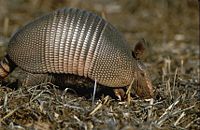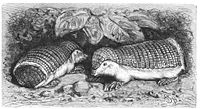Armadillo
| Armadillos | ||||||||||
|---|---|---|---|---|---|---|---|---|---|---|
 Nine-banded Armadillo
| ||||||||||
| Scientific classification | ||||||||||
| ||||||||||
|
Armadillos are small placental mammals, known for having a bony armor shell. The Dasypodidae are the only surviving family in the order Cingulata. Until as recently as 1995, the family was placed in the order Xenarthra, along with the anteaters and sloths.
There are approximately 10 extant genera and around 20 extant species of armadillo, some of which are distinguished by the number of bands on their armor. Their average length is about 75 centimeters (30 in), including tail; the Giant Armadillo reaches roughly 90 cm (3 ft), while the Pink Fairy Armadillos are diminutive species with an overall length of 12–15 cm (4–5 in). All species are native to the Americas, where they inhabit a variety of environments. In the United States, the sole resident armadillo is the Nine-banded Armadillo (Dasypus novemcinctus), which is most common in the central southernmost states, particularly Texas.
Overview
Edentata
Cingulata
Xenarthra
Description
Armadillos are prolific diggers, and many species use their sharp claws to dig for food such as grubs, and to dig dens. The Nine-banded Armadillo prefers to build burrows in moist soil near the creeks, streams and arroyos near which it lives and feeds. The diet of different armadillo species varies, but consists mainly of insects, grubs and other invertebrates. Some species, however, are almost entirely formicivorous (feeding mainly on ants).
Armadillos have poor vision but are not blind.
The armor is formed by plates of dermal bone covered in small, overlapping epidermal scales called "scutes". This armor-like skin appears to be the main defense of many armadillos, although most escape predators by fleeing (often into thorny patches, from which their armor protects them) or digging to safety. Only the South American three-banded armadillos (Tolypeutes) rely heavily on their armor for protection. When threatened by a predator, Tolypeutes species frequently roll up into a ball. (Other armadillo species cannot roll up because they have too many plates.) The North American Nine-banded Armadillo tends to jump straight in the air when surprised, and consequently often collides with the undercarriage or fenders of passing vehicles.[1]
Armadillos have short legs but can move quickly, and have the ability to remain underwater for as long as six minutes. Because of the weight of its armor, an armadillo will sink in water unless it inflates its stomach with air, which often doubles its size.[2]
Armadillos use their claws for digging and finding food, as well as for making their homes in burrows. They dig their burrows with their claws, only making a single corridor where they fit themselves.
Classification
Order CINGULATA
- †Family Pampatheriidae: giant armadillos
- †Family Glyptodontidae: glyptodonts
- Genus †Glyptodon
- Genus †Doedicurus
- Genus †Hoplophorus
- Genus †Panochthus
- Genus †Plaxhaplous
- Family Dasypodidae: armadillos
- Subfamily Dasypodinae
- Genus Dasypus
- Nine-banded Armadillo or Long-nosed Armadillo, Dasypus novemcinctus
- Seven-banded Armadillo, Dasypus septemcinctus
- Southern Long-nosed Armadillo, Dasypus hybridus
- Llanos Long-nosed Armadillo, Dasypus sabanicola
- Great Long-nosed Armadillo, Dasypus kappleri
- Hairy Long-nosed Armadillo, Dasypus pilosus
- †Beautiful Armadillo, Dasypus bellus
- Genus Dasypus
- Subfamily Euphractinae
- Genus Calyptophractus
- Greater Fairy Armadillo, Calyptophractus retusus
- Genus Chaetophractus
- Screaming Hairy Armadillo, Chaetophractus vellerosus
- Big Hairy Armadillo, Chaetophractus villosus
- Andean Hairy Armadillo, Chaetophractus nationi
- Genus †Peltephilus
- Horned Armadillo, Peltephilus ferox
- Genus Calyptophractus
- Subfamily Dasypodinae
- Genus Chlamyphorus
- Pink Fairy Armadillo, Chlamyphorus truncatus
- Genus Euphractus
- Six-banded Armadillo, Euphractus sexcinctus
- Genus Zaedyus
- Pichi, Zaedyus pichiy
- Genus Chlamyphorus
- Subfamily Tolypeutinae
- Genus Cabassous
- Northern Naked-tailed Armadillo, Cabassous centralis
- Chacoan Naked-tailed Armadillo, Cabassous chacoensis
- Southern Naked-tailed Armadillo, Cabassous unicinctus
- Greater Naked-tailed Armadillo, Cabassous tatouay
- Genus Priodontes
- Giant Armadillo, Priodontes maximus
- Genus Tolypeutes
- Southern Three-banded Armadillo, Tolypeutes matacus
- Brazilian Three-banded Armadillo, Tolypeutes tricinctus
- Genus Cabassous
† indicates extinct taxon
Armadillos and humans
In science
Armadillos are often used in the study of leprosy, since they, along with mangabey monkeys, rabbits and mice (on their footpads), are among the few known non-human animal species that can contract the disease systemically. They are particularly susceptible due to their unusually low body temperature, which is hospitable to the leprosy bacterium.
The Nine-banded Armadillo also serves science through its unusual reproductive system, in which four identical quadruplets (all the same sex) are born in each litter.[3] Because they are always identical, the group of four young provides a good subject for scientific, behavioral or medical tests that need consistent biological and genetic makeup in the test subjects. This phenomenon of multiple identical birth, called polyembryony, only manifests in the genus Dasypus and not in all armadillos, as is commonly believed.
Armadillos (mainly Dasypus) make common roadkill due to their habit of jumping to about fender height when startled (such as by an oncoming car). Wildlife enthusiasts are using the northward march of the armadillo as an opportunity to educate others about the animals, which can be a burrowing nuisance to homeowners, cemetery caretakers and golf course superintendents.[3]
In popular culture
Armadillo is Spanish for "little armored one", referring to their outer skin that looks like armor. During the Great Depression, this species was known as "Hoover Hog" by down-on-their luck Americans who had to eat them instead of the "chicken in every pot" Herbert Hoover had promised as President.[4] Earlier, German settlers in Texas would often refer to the armadillo as Panzerschwein ("armored pig").
The Nine-banded Armadillo was, with some resistance, made the state small mammal of Texas,[5] where it is considered a pest and is often seen dead on the roadside. They first forayed into Texas across the Rio Grande from Mexico in the 1800s, eventually spreading across the southeast United States.[4]
Northwestern University holds an annual music festival entitled Dillo Day, named after the armadillo, on the Saturday before Memorial Day.
In the film Necessary Roughness, the school mascot for the fictional university used, is the Texas State Armadillos.
In the United Kingdom the armadillo ("smooth on the inside, crunchy on the outside") featured prominently in a television commercial for the Dime Bar chocolate bar.
In an episode of Friends, Ross is unable to get a Santa costume to celebrate the Christmas holiday with his son, so instead he hires the last remaining costume: an Armadillo costume, and dons the name "Holiday Armadillo".
The Clash video "Rock the Casbah" filmed in Austin, Texas features an armadillo strolling down the streets.
Notes and References
- A. Gardner, "Order *," pages 94-99 in D. E. Wilson and D. M. Reeder, eds. Mammal Species of the World: A Taxonomic and Geographic Reference, 3rd edition. (Baltimore: Johns Hopkins University Press, 2005). ISBN 0801882214.
External links
| Mammals |
|---|
| Monotremata (platypus, echidnas) |
|
Marsupialia: | Paucituberculata (shrew opossums) | Didelphimorphia (opossums) | Microbiotheria | Notoryctemorphia (marsupial moles) | Dasyuromorphia (quolls and dunnarts) | Peramelemorphia (bilbies, bandicoots) | Diprotodontia (kangaroos and relatives) |
|
Placentalia: Cingulata (armadillos) | Pilosa (anteaters, sloths) | Afrosoricida (tenrecs, golden moles) | Macroscelidea (elephant shrews) | Tubulidentata (aardvark) | Hyracoidea (hyraxes) | Proboscidea (elephants) | Sirenia (dugongs, manatees) | Soricomorpha (shrews, moles) | Erinaceomorpha (hedgehogs and relatives) Chiroptera (bats) | Pholidota (pangolins)| Carnivora | Perissodactyla (odd-toed ungulates) | Artiodactyla (even-toed ungulates) | Cetacea (whales, dolphins) | Rodentia (rodents) | Lagomorpha (rabbits and relatives) | Scandentia (treeshrews) | Dermoptera (colugos) | Primates | |
Credits
New World Encyclopedia writers and editors rewrote and completed the Wikipedia article in accordance with New World Encyclopedia standards. This article abides by terms of the Creative Commons CC-by-sa 3.0 License (CC-by-sa), which may be used and disseminated with proper attribution. Credit is due under the terms of this license that can reference both the New World Encyclopedia contributors and the selfless volunteer contributors of the Wikimedia Foundation. To cite this article click here for a list of acceptable citing formats.The history of earlier contributions by wikipedians is accessible to researchers here:
The history of this article since it was imported to New World Encyclopedia:
Note: Some restrictions may apply to use of individual images which are separately licensed.


